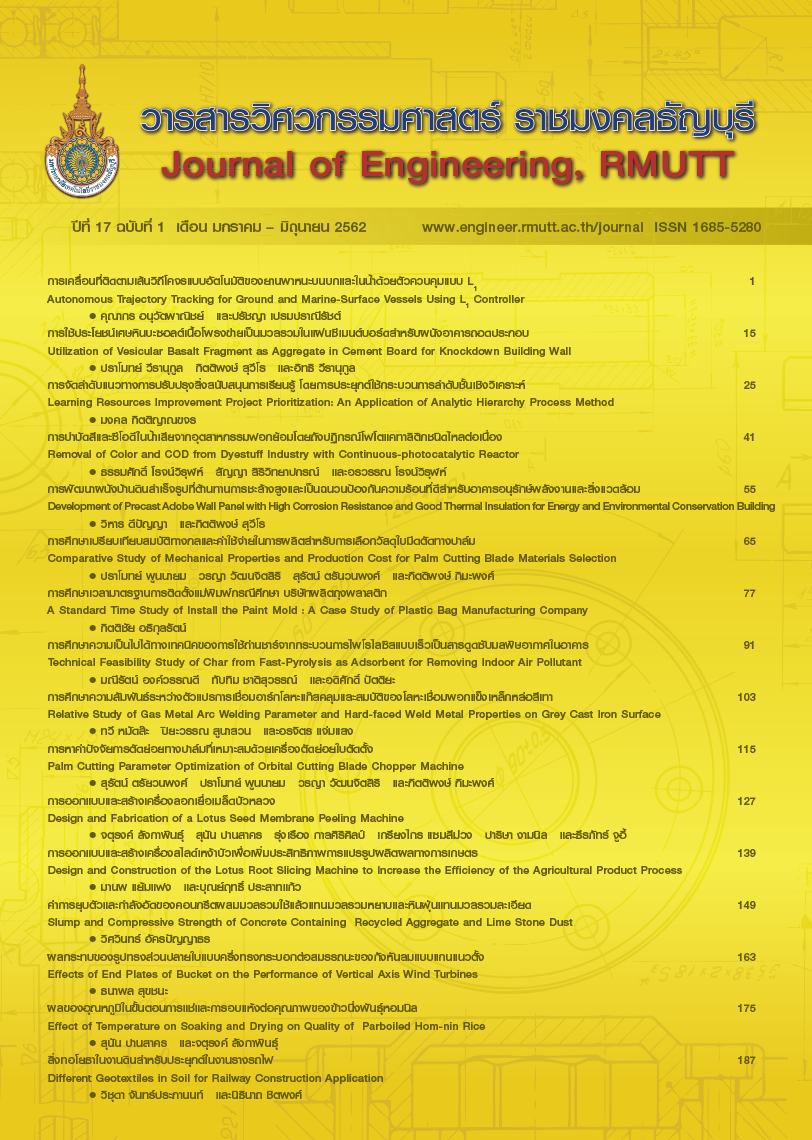Technical Feasibility Study of Char from Fast-Pyrolysis as Adsorbent for Removing Indoor Air Pollutant
Main Article Content
Abstract
This research was to characterize physical and chemical properties of char obtained from fast pyrolysis of two biomass types, i.e. sawdust and acacia wood, in order to use char as an adsorbent for removal of indoor air pollutants. Studied chars were tested as follows: adsorption isotherm for gaseous toluene used as a representative of a volatile organic compound, iodine number, specific surface area and pore characteristics, functional groups on the surface, and morphology by scanning electron microscopy (SEM). The Freundlich isotherm indicated that both chars provided favorable adsorption isotherms. The acacia-wood char had specific adsorption capacity and Freundlich isotherm exponent closer to the activated carbon. Iodine numbers of the acacia-wood and sawdust chars were 731 and 802 mg/g, respectively. The specific surface area and mean pore size of the acacia-wood char were twice as large as those of the sawdust char. These results agreed with SEM images that showed capillary-like pores and greater open pores found in the acacia-wood char than in the sawdust char. The similar functional group of aromatic bonds was observed on the surfaces of both chars. According to these properties, the acacia-wood char is capable of directly using as an adsorbent for removing aromatic indoor pollutants. Furthermore, improvement of the char properties by activation and addition of particular functional groups on the surfaces can increase the char ability to adsorb odors and other air pollutants.
Article Details
The manuscript, information, content, picture and so forth which were published on Frontiers in engineering innovation research has been a copyright of this journal only. There is not allow anyone or any organize to duplicate all content or some document for unethical publication.
References
Bridgwater AV. Review of fast pyrolysis of biomass and product upgrading. Biomass and Bioenergy. 2012;38:68-94.
Jenkins LP, Phillips JT, Molberg SE, Hui PS. Activity patterns of californians: use of and proximity to indoor pollutant sources. Atmospheric Environment. 1992;26A:2141-3148.
United States Environmental Protection Agency [Internet]. Why indoor air quality is important to schools. 2017 [cited 2017 December 20]. Available from: https://www.epa.gov/iaq-schools/why-indoor-air-quality-important-schools.
Hedge A. Work-related illness in offices: a proposed model of the sick building syndrome. Environmental International. 1989;15:143-158.
Ten Brinke J, Selvin S, Hodgson TA, Fisk JW, Mendell JM, Koshland PC, Daisey MJ. Development of new volatile organic compound (VOC) exposure metrics and relationship to sick building syndromes. Indoor Air. 1989;8:140-152.
Godish T. Indoor air pollution control. Michigan: Lewis; 1989.
Tieosuwan P. Designing a range of home decoration products that help eliminate unwanted odor and absorb humidity condominium by utilizing the attributes of charcoal [master’s independent study]. Nakhon Pathom: Silpakorn University; 2014.
Ongwandee M, Moonrinta R, Panyame theekul S, Tangbanluekal C, Morrison G. Investigation of volatile organic compounds in office buildings in Bangkok, Thailand: concentrations, sources and occupant symptoms. Building and Environment. 2011;46:1512-1522.
DiGiano FA, Weber WJ. Process dynamics in environmental systems. New York: Wiley & Sons; 1996.
Berthouex PM, Brown LC. Statistics for environmental engineering. Florida: Lewis; 1994.
American Society for Testing and Materials. ASTM D4607-86 Standard test method for determination of iodine number of activated carbon. Philadelphia: ASTM Committee on Standards; 1986.
Katesa J. Effects of carbonization temperature on properties of chars and activated carbon from coconut shell [master’s thesis]. Nakhon Ratchasima: Suranaree University of Technology; 2013.
Thai Industrial Standard. TIS 900-2547 activated carbon. Bangkok: Thai Industrial Standard Institute; 2004.
Friedel RA, Hofer LJE. Spectral characterization of activated carbon. The Journal of Physical Chemistry. 1970;74:2921-2922.
Abugu HO, Okoye PAC, Ajiwe VIE, Omuku PE, Umeobika UC. Preparation and charac-terization of activated carbon produced from oil bean (Ugba or Ukpaka) and snail shell. Environmental Analytical Chemistry. 2015;2:1-17.


